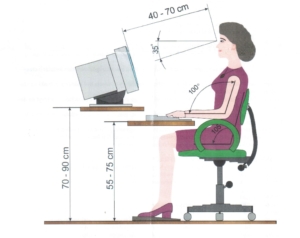A while ago, we covered the topic of computer eye strain. Sadly, it’s not the only condition affecting those of us, who adopt a more sedentary lifestyle. For a great number of people nowadays, work-related back pain is an unavoidable part of their daily lives. It seems to be a ubiquitous issue common in many professions, whose members spend long hours in front of computer screens. Web developers, architects, graphic designers, and yes, translators too, often complain about back discomfort. What can you do to stop it or prevent it? Fortunately, sometimes even a really minor changes can make a world of difference.
Work-related back pain: causes
Incorrect sitting position causes improper spinal posture and may trigger pain in the cervical, thoracic and lumbar segments. This is because your muscles get shortened and
are constantly kept in tension. There is also pressure on the blood vessels and peripheral nerves.
Unfortunately our anatomical structure is not adapted to a sitting position. All the more so, to stay in one for a few hours a day. Did you know that, if you weigh about 70 kg, the pressure on the lumbar spine, when sitting, for instance while working at a computer, is 140 kg? No wonder that after a few hours spent at your desk, it's hard to straighten up. The whole pressure is transferred to joint and periarticular structures, which, over time causes accumulation of micro-injuries, development of pain, inflammation and degenerative changes.

Work-related back pain: solutions
With a sedentary lifestyle, it’s not very difficult to overpressure your back. However, there are a few general rules to counteract the injuries. Perhaps the most important thing to remember is taking regular exercise. Naturally, you should adapt the intensity to your shape and well-being. Furthermore, apart from improving the overall condition of our body, it’s also important to take care of specific muscles. You shouldn’t forget about strengthening the forearm muscles with a gradually increasing load. Another thing not to overlook is taking frequent breakes both when doing sports and working. That way you will have a chance to relax and stretch the tensed muscles.
Adjust your desk
Preventing back fatigue might entail changes to your working environment. Fortunately, with a few simple steps, you can easily make the pain go away. First of all, make sure your desk and monitor are properly adjusted. Unfortunately there are no one-size-fits-all solutions here since each of us has different needs. In the view of this fact, the optimal solution is a desk with height adjustment, so that it is suitable for people shorter or taller than average. Ideal height means that the angle between the arm and the forearm is about 100 degrees. Secondly, place your monitor so that it is between 40 and 70 cm and about 35 degrees below the line of sight. The screen ought to be perpendicular to your face. What’s more, never forget to keep both of your feet flat on the ground. If it helps, you might consider purchasing a footrest.
Ergonomic chair
Another element that will allow you to prevent work-related back pain is a proper chair. A great idea is to look for an appropriate ergonomic chair with good lumbar and neck support. Moreover, it’s worth paying attention to whether it has adjustable armrests too. It seems that poor body alignment is the main culprit when it comes to back fatigue.
Many people who work for a long time in front of a computer do not think about the health consequences that this work can cause and do not pay attention to ergonomics and
work hygiene. Since, prevention is better than cure, as they say, perhaps it would be wiser to take a second look at your work environment and introduce necessary changes.










